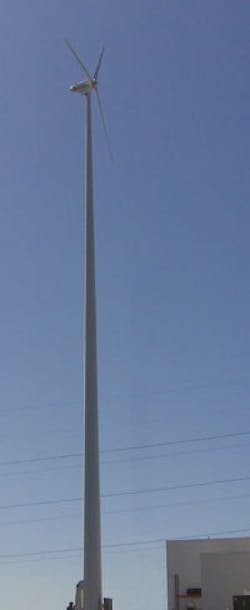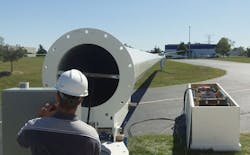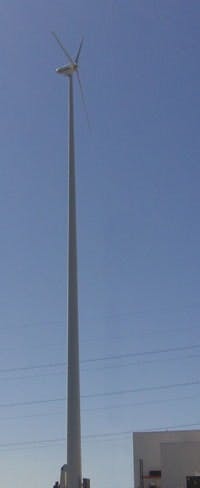Wago Erects 100 Ft Wind Turbine in Germantown
It was like the Egyptian obelisk going up in “The 10 Commandments,” only it was a lot faster, and the slaves were replaced by portable hydraulics. Oh, and there was a 32 ft diameter fan at the top.
This was the scene on a sunny, early-September afternoon as Wago installed a 100 ft tall wind turbine next to its U.S. headquarters in Germantown, Wis. And, as if the gleaming white tower wasn’t impressive enough, it was “tipped up” in an amazing 8-10 minutes by a portable hydraulic unit hooked up right next to the tower. After that, it took only another 15 minutes to bolt down the tower, hook up its electronics, and get it spinning in the breeze of Wisconsin’s famous “dairy air.”
Capable of generating 20 kW for Wago’s multi-function facility, the small-scale, commercial-grade VP-20 turbine was built by Renewegy in nearby Oshkosh, Wis. The turbine employs Wago’s 787 Series power supplies, 756 Series cables/connectors, 288 Series fuse blocks and backup capacitor module.
The wind turbine’s initial cost was $80,000, but state and federal incentives allow Wago to reduce its bill by about $35,000. Other VP-20s have been installed at SCA Tissue in Neenah, Wis., and at the North Texas Job Corp Center in McKinney, Texas. Renewegy reports that it can install single 20 kW units on farms, 40 kW dual units to serve schools, and 100 kW five-unit systems for small wind farms and commercial applications.
VP-20’s three blades are usually situated at a 10° pitch, but they can be turned to achieve as much as a 110° pitch to better handle variable wind speeds and improve power output. Its variable-pitch (VP) capability is patterned after utility-scale turbines, and it controls pitch for each blade to within 0.1° while pitching at speeds up to 15° per second. A closed-loop, Active-Pitch servo manages blade speeds in wind conditions of 6.7–55.9 mph, and an Active-Yaw servo ensures optimum power generation by directing the blades into the wind.
At 100 rpm, the turbine begins to produce power, and at 110 rpm it generates its normal 20 kW. Wind power from the turbine will meet about 10% of Wago’s electrical needs needs at its engineering, manufacturing and sales hub. Also, by producing more of its electricity onsite and using less from the local grid, Wago will save half again as much electricity because its local utility won’t have to generate, send and lose as much power by sending it a long distance.
“Renewegy’s inventive hydraulic tip-up function demonstrates Wisconsin ingenuity and manufacturing capabilities,” said Tom Artmann, Wago’s president. “We’re proud that our products are supporting VP-20s nationwide, and are looking forward to supplementing our manufacturing facility with renewable energy.”
The VP-20’s dramatic tip-up capability is enabled by its unique, monopole Tip-Down tower, which enables Renewegy’s portable hydraulic cylinder system to raise it at installation, and then come back later and easily lower it for servicing. This tip-up method eliminates the high cost and time required by the large cranes and heavy-duty equipment used to install and help maintain larger wind turbine towers.
Because power supply and signaling reliability are essential for coping with widely variable wind conditions, Renewegy specified Wago’s IP67-grade 756 Series cables and connectors for the VP-20’s microprocessor-driven control system. Crucial for safety and reliability, these connections resist dust, water and mechanical loosening caused by vibrations.
Likewise, the VP-20’s control cabinet is supported by Wago’s 288 Series capacitor backup module and 787 Series Epsitron Pro 24 Vdc power supplies. They were specified because they feature PowerBoost, which provides twice the current at constant voltage for about 4 s, which helps ensure reliable, cold-weather startups. VP-20’s controls also include Rockwell Automation’s Allen-Bradley Soft Starter to help ramp current between the turbine and its induction generator, and E3 overload relays to measure voltage and current.
The VP-20 uses CANbus for internal communications, and then converts to Ethernet for longer-distance communications. For example, Renewegy can monitor the wind turbine, and even remotely turn it on or off, if needed.
Besides the wind turbine, Wago reports it’s already been saving 10-20% on lighting by installing high-efficiency fluorescents from Orion Energy Systems in Manitowoc, Wis. It’s also using Circon Systems’ sensors, controllers and networking to automate its lighting, HVAC and fans, which had shaved its electric bill by an additional $1,000 per month.



